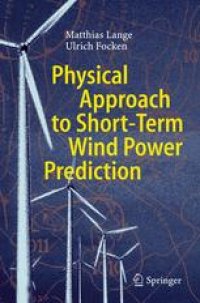
Ebook: Physical Approach to Short-Term Wind Power Prediction
- Tags: Renewable Energy Sources, Meteorology/Climatology, Mechanics Fluids Thermodynamics, Electrical Power Generation and Transmission, Environmental Physics
- Year: 2006
- Publisher: Springer-Verlag Berlin Heidelberg
- Edition: 1
- Language: English
- pdf
From the reviews:
"The book was triggered by the dramatically boomed wind energy utilisation. … It is a text book for boundary-layer meteorology, flow simulation, time series analyses and modelling of the behaviour of wind farms also. So the models are well described and their application for wind power prediction is demonstrated. … The book is provided for scientists and engineers mainly. The text is written very clear. It is completed by 89 figures and 13 tables." (K. Schäfer, Meteorologische Zeitschrift, Vol. 16 (3), 2007)
The effective integration of wind energy into the overall electricity supply is a technical and economical challenge because the availability of wind power is determined by fluctuating meteorological conditions. This book offers an approach to the ultimate goal of the short-term prediction of the power output of winds farms. Starting from basic aspects of atmospheric fluid dynamics, the authors discuss the structure of winds fields, the available forecast systems and the handling of the intrinsic, weather-dependent uncertainties in the regional prediction of the power generated by wind turbines. This book addresses scientists and engineers working in wind energy related R and D and industry, as well as graduate students and nonspecialists researchers in the fields of atmospheric physics and meteorology.
The effective integration of wind energy into the overall electricity supply is a technical and economical challenge because the availability of wind power is determined by fluctuating meteorological conditions. This book offers an approach to the ultimate goal of the short-term prediction of the power output of winds farms. Starting from basic aspects of atmospheric fluid dynamics, the authors discuss the structure of winds fields, the available forecast systems and the handling of the intrinsic, weather-dependent uncertainties in the regional prediction of the power generated by wind turbines. This book addresses scientists and engineers working in wind energy related R and D and industry, as well as graduate students and nonspecialists researchers in the fields of atmospheric physics and meteorology.
Content:
Front Matter....Pages I-XII
Introduction....Pages 1-6
Overview of Wind Power Prediction Systems....Pages 7-22
Foundations of Physical Prediction Models....Pages 23-38
Physical Wind Power Prediction Systems....Pages 39-53
Data....Pages 55-60
Assessment of the Prediction Accuracy....Pages 61-90
Correction of Wind Profiles Due to Thermal Stratification....Pages 91-114
Assessment of Wind Speed Dependent Prediction Error....Pages 115-133
Relating the Forecast Error to Meteorological Situations....Pages 135-167
Smoothing Effects in Regional Power Prediction....Pages 169-178
Outlook....Pages 179-181
Back Matter....Pages 183-208
The effective integration of wind energy into the overall electricity supply is a technical and economical challenge because the availability of wind power is determined by fluctuating meteorological conditions. This book offers an approach to the ultimate goal of the short-term prediction of the power output of winds farms. Starting from basic aspects of atmospheric fluid dynamics, the authors discuss the structure of winds fields, the available forecast systems and the handling of the intrinsic, weather-dependent uncertainties in the regional prediction of the power generated by wind turbines. This book addresses scientists and engineers working in wind energy related R and D and industry, as well as graduate students and nonspecialists researchers in the fields of atmospheric physics and meteorology.
Content:
Front Matter....Pages I-XII
Introduction....Pages 1-6
Overview of Wind Power Prediction Systems....Pages 7-22
Foundations of Physical Prediction Models....Pages 23-38
Physical Wind Power Prediction Systems....Pages 39-53
Data....Pages 55-60
Assessment of the Prediction Accuracy....Pages 61-90
Correction of Wind Profiles Due to Thermal Stratification....Pages 91-114
Assessment of Wind Speed Dependent Prediction Error....Pages 115-133
Relating the Forecast Error to Meteorological Situations....Pages 135-167
Smoothing Effects in Regional Power Prediction....Pages 169-178
Outlook....Pages 179-181
Back Matter....Pages 183-208
....